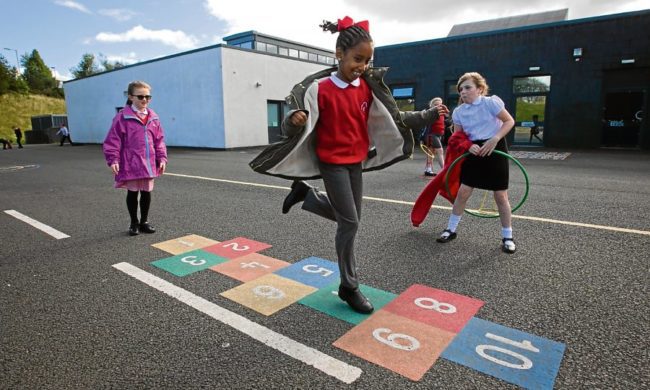Active play is a novel approach to addressing low physical activity levels and fundamental movement skills (FMS) in children. This study aimed to determine if a new school-based, ‘Go2Play Active Play’ intervention improved school day physical activity and FMS. This was a pragmatic evaluation conducted in Scotland during 2015–16. Participants (n = 172; mean age = 7 years) were recruited from seven primary schools taking part in the 5-month intervention, plus 24 participants not receiving the intervention were recruited to act as a comparison group.189 participants had physical activity measured using an Actigraph GT3X accelerometer at baseline and again at follow-up 5 months later. A sub-sample of participants from the intervention (n = 102) and comparison (n = 21) groups had their FMS assessed using the Test of Gross Motor Development (TGMD-2) at baseline and follow-up. Changes in school day physical activity and FMS variables were examined using repeated measures ANOVA. The main effect was ‘group’ on ‘time’ from baseline to follow-up. Results indicated there was a significant interaction for mean counts per minute and percent time in sedentary behavior, light intensity physical activity and moderate to vigorous physical activity (MVPA) (all p < 0.01) for school day physical activity. There was a significant interaction for gross motor quotient (GMQ) score (p = 0.02) and percentile (p = 0.04), locomotor skills score and percentile (both p = 0.02), but no significant interaction for object control skills score (p = 0.1) and percentile (p = 0.3). The Go2Play Active Play intervention may be a promising way of improving physical activity and FMS but this needs to be confirmed in an RCT.
Read the Research
References:
- Adamo K.B., Wilson S., Harvey A.L. Does intervening in childcare settings impact fundamental movement skill development? Med. Sci. Sports Exerc. 2016;48(5):926–932. [PubMed] [Google Scholar]
- Association for Physical Education 2008. http://www.afpe.org.uk/physical-education/wp-content/uploads/afPE_Health_Position_Paper_Web_Version2015.pdf (accessed 17th June 2016)
- Barnett L.M., van Beurden E., Morgan P.J., Brooks L.O., Zask A., Beard J.R. Six year follow-up of students who participated in a school-based physical activity intervention: a longitudinal cohort study. Int. J. Behav. Nutr. Phys. Act. 2009;6:48. [PMC free article] [PubMed] [Google Scholar]
- Basterfield L., Adamson A.J., Parkinson K.N. Surveillance of physical activity in the UK is flawed: validation of the Health Survey for England Physical Activity Questionnaire. Arch. Dis. Child. 2008;93(12):1054–1058. [PubMed] [Google Scholar]
- Basterfield L., Adamson A.J., Pearce M.S., Reilly J.J. Stability of habitual physical activity and sedentary behavior monitoring by accelerometry in 6- to 8-year-olds. J. Phys. Act. Health. 2011;8(4):543–547. [PubMed] [Google Scholar]
- Belton S., O’Brien W., Issartel J., McGrane B., Powell D. Where does the time go? Patterns of physical activity in adolescent youth. J. Sci. Med. Sport. 2016;19(11):921–925. [PubMed] [Google Scholar]
- Brazendale K., Chandler J.L., Beets M.W. Maximizing children’s physical activity using the LET US Play principles. Prev. Med. 2015;76:14–19. [PMC free article] [PubMed] [Google Scholar]
- Brockman R., Jago R., Fox K.R. The contribution of active play to the physical activity of primary school children. Prev. Med. 2010;51(2):144–147. [PMC free article] [PubMed] [Google Scholar]
- Cooper A.R., Page A.S., Wheeler B.W., Hillsdon M., Griew P., Jago R. Patterns of GPS measured time outdoors after school and objective physical activity in English children: the PEACH project. Int. J. Behav. Nutr. Phys. Act. 2010;7:31. [PMC free article] [PubMed] [Google Scholar]
- Department of Health StartActive, Stay Active. 2011. https://www.gov.uk/government/uploads/system/uploads/attachment_data/file/216370/dh_128210.pdf (accessed 15th June 2016)
- Dobbins M., De Corby K., Robeson P., Husson H., Tirilis D. School-based physical activity programs for promoting physical activity and fitness in children and adolescents aged 6–18. Cochrane Database Syst. Rev. 2009;1 [PubMed] [Google Scholar]
- Evenson K.R., Catellier D.J., Gill K., Ondrak K.S., McMurray R.G. Calibration of two objective measures of physical activity for children. J. Sports Sci. 2008;26(14):1557–1565. [PubMed] [Google Scholar]
- Fisher A., Reilly J.J., Kelly L.A. Fundamental movement skills and habitual physical activity in young children. Med. Sci. Sports Exerc. 2005;37(4):684–688. [PubMed] [Google Scholar]
- Fisher A., Reilly J., Montgomery C. Seasonality in physical activity and sedentary behavior in young children. Pediatr. Exerc. Sci. 2005;17:31–40. [Google Scholar]
- Gray C., Gibbons R., Larouche R. What is the relationship between outdoor time and physical activity, sedentary behaviour, and physical fitness in children? A systematic review. Int. J. Environ. Res. Public Health. 2015;12(6):6455–6474. [PMC free article] [PubMed] [Google Scholar]
- Hardy L.L., Reinten-Reynolds T., Espinel P., Zask A., Okely A.D. Prevalence and correlates of low fundamental movement skill competency in children. Pediatrics. 2012;130(2):e390–e398. [PubMed] [Google Scholar]
- Healthy Behaviours in School Children (HBSC) Findings From the HBSC 2014 Survey in Scotland. 2015. http://www.cahru.org/content/03-publications/04-reports/hbsc_nr14_interactive_final.pdf (accessed 21st June)
- Hollis J.L., Williams A.J., Sutherland R. A systematic review and meta-analysis of moderate-to-vigorous physical activity levels in elementary school physical education lessons. Prev. Med. 2016;86:34–54. [PubMed] [Google Scholar]
- Janssen I. Active play: an important physical activity strategy in the fight against childhood obesity. Can. J. Public Health. 2014;105(1):e22–e27. [PMC free article] [PubMed] [Google Scholar]
- Janssen I., Leblanc A.G. Systematic review of the health benefits of physical activity and fitness in school-aged children and youth. Int. J. Behav. Nutr. Phys. Act. 2010;7:40. [PMC free article] [PubMed] [Google Scholar]
- Jones R.A., Riethmuller A., Hesketh K., Trezise J., Batterham M., Okely A.D. Promoting fundamental movement skill development and physical activity in early childhood settings: a cluster randomized controlled trial. Pediatr. Exerc. Sci. 2011;23(4):600–615. [PubMed] [Google Scholar]
- King A.C., Parkinson K.N., Adamson A.J. Correlates of objectively measured physical activity and sedentary behaviour in English children. Eur. J. Pub. Health. 2011;21(4):424–431. [PubMed] [Google Scholar]
- Lai S.K., Costigan S.A., Morgan P.J. Do school-based interventions focusing on physical activity, fitness, or fundamental movement skill competency produce a sustained impact in these outcomes in children and adolescents? A systematic review of follow-up studies. Sports Med. 2014;44(1):67–79. [PubMed] [Google Scholar]
- Logan S.W., Robinson L.E., Wilson A.E., Lucas W.A. Getting the fundamentals of movement: a meta-analysis of the effectiveness of motor skill interventions in children. Child Care Health Dev. 2012;38(3):305–315. [PubMed] [Google Scholar]
- Lubans D.R., Morgan P.J., Cliff D.P., Barnett L.M., Okely A.D. Fundamental movement skills in children and adolescents: review of associated health benefits. Sports Med. 2010;40(12):1019–1035. [PubMed] [Google Scholar]
- Marshall S.J., Gorely T., Biddle S.J. A descriptive epidemiology of screen-based media use in youth: a review and critique. J. Adolesc. 2006;29(3):333–349. [PubMed] [Google Scholar]
- Martin A., Boyle J., Corlett F., Kelly P., Reilly J.J. Contribution of walking to school to individual and population moderate-vigorous intensity physical activity: systematic review and meta-analysis. Pediatr. Exerc. Sci. 2016;28(3):353–363. [PubMed] [Google Scholar]
- Nettlefold L., McKay H.A., Warburton D.E., McGuire K.A., Bredin S.S., Naylor P.J. The challenge of low physical activity during the school day: at recess, lunch and in physical education. Br. J. Sports Med. 2011;45(10):813–819. [PubMed] [Google Scholar]
- O’Brien W., Belton S., Issartel J. Fundamental movement skill proficiency amongst adolescent youth. Phys. Educ. Sport Pedagog. 2015;28:1–5. [Google Scholar]
- Reilly J.J. When does it all go wrong? Longitudinal studies of changes in moderate-to-vigorous-intensity physical activity across childhood and adolescence. J. Exerc. Sci. Fit. 2016;14:1–6. [PMC free article] [PubMed] [Google Scholar]
- Reilly J.J., Johnstone A., McNeill G., Hughes A.R. Results from Scotland’s 2016 report card on physical activity for children and youth. J. Phys. Act. Health. 2016 Nov;13(11 Suppl. 2):S251–S255. [PubMed] [Google Scholar]
- Reilly J.J., Johnston G., McIntosh S., Martin A. Contribution of school recess to daily physical activity: systematic review and evidence appraisal. Health Behav. Policy Rev. 2016;3:581–589. [Google Scholar]
- Salmon J., Ball K., Hume C., Booth M., Crawford D. Outcomes of a group-randomized trial to prevent excess weight gain, reduce screen behaviours and promote physical activity in 10-year-old children: switch-play. Int. J. Obes. 2008;32(4):601–612. [PubMed] [Google Scholar]
- Story M., Nanney M.S., Schwartz M.B. Schools and obesity prevention: creating school environments and policies to promote healthy eating and physical activity. Milbank Q. 2009;87(1):71–100. [PMC free article] [PubMed] [Google Scholar]
- van Stralen M.M., Yıldırım M., Wulp A. Measured sedentary time and physical activity during the school day of European 10- to 12-year-old children: the ENERGY project. J. Sci. Med. Sport. 2014;17(2):201–206. [PubMed] [Google Scholar]
- The Scottish Government The Scottish Index of Multiple Deprivation. 2016. http://www.gov.scot/Topics/Statistics/SIMD (accessed 1st July 2016)
- Timmons B.W., Leblanc A.G., Carson V. Systematic review of physical activity and health in the early years (aged 0–4 years) Appl. Physiol. Nutr. Metab. 2012;37(4):773–792. [PubMed] [Google Scholar]
- Tremblay M.S., Gray C.E., Akinroye K. Physical activity of children: a global matrix of grades comparing 15 countries. J. Phys. Act. Health. 2014;11(Suppl. 1):S113–S125. [PubMed] [Google Scholar]
- Truelove S., Vanderloo L.M., Tucker P. Defining and measuring active play among young children: a systematic review. J. Phys. Act. Health. 2016:1–32. [PubMed] [Google Scholar]
- Ulrich D.A. Prod-EdProd-Ed; Austin: 2000. Test of Gross Motor Development-2. [Google Scholar]
- Veitch J., Bagley S., Ball K., Salmon J. Where do children usually play? A qualitative study of parents’ perceptions of influences on children’s active free-play. Health Place. 2006;12(4):383–393. [PubMed] [Google Scholar]
- Verstraete S.J., Cardon G.M., De Clercq D.L., De Bourdeaudhuij I.M. Increasing children’s physical activity levels during recess periods in elementary schools: the effects of providing game equipment. Eur. J. Pub. Health. 2006;16(4):415–419. [PubMed] [Google Scholar]
- Whitehead M. The concept of physical literacy. Eur. J. Phys. Educ. 2001;6(2):127–138. [Google Scholar]
- Wiart L., Darrah J. Review of four tests of gross motor development. Dev. Med. Child Neurol. 2001;43(4):279–285. [PubMed] [Google Scholar]

